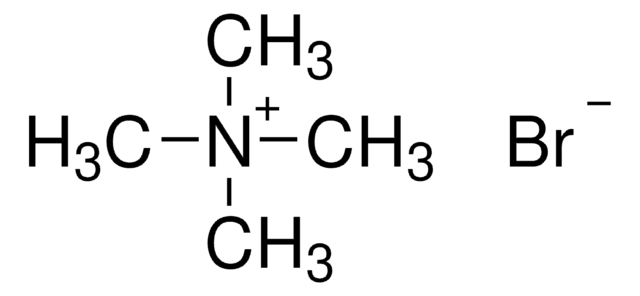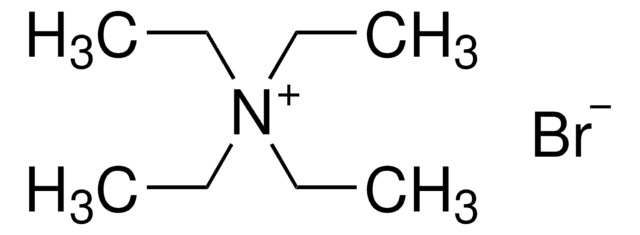Key Documents
193119
Tetrabutylammonium bromide
ReagentPlus®, ≥99.0%
Synonim(y):
TBAB
About This Item
Polecane produkty
Poziom jakości
linia produktu
ReagentPlus®
Próba
≥99.0%
Postać
powder, crystals or granules
pH
6.48 (30 °C)
mp
102-106 °C (lit.)
rozpuszczalność
ethanol: 50 mg/mL, clear, colorless to light yellow
ciąg SMILES
[Br-].CCCC[N+](CCCC)(CCCC)CCCC
InChI
1S/C16H36N.BrH/c1-5-9-13-17(14-10-6-2,15-11-7-3)16-12-8-4;/h5-16H2,1-4H3;1H/q+1;/p-1
Klucz InChI
JRMUNVKIHCOMHV-UHFFFAOYSA-M
Szukasz podobnych produktów? Odwiedź Przewodnik dotyczący porównywania produktów
Powiązane kategorie
Opis ogólny
Zastosowanie
- 1-cyano-2-thiophenylethane
- 1-cyano-2-thiobutylethane
- 1-cyano-2-(2-aminothiophenyl)ethane
- methyl 3-thiophenylpropionate
- methyl 3-thiobutylpropionate
- methyl 2-methyl-3-thiophenylpropionate
- methyl 2-methyl-3-thiobutylpropionate
- diethyl 2-thiophenylsuccinate
- diethyl 2-thiobutylsuccinate
- 3-(4-chlorophenyl)-2-nitro-2-thiophenylpropane
- 4-(4-chlorophenyl)-3-nitro-4-thiobutylbutane
- 3-thiophenylcyclohexanone
- 3-thioethylcyclohexanone
- 4-methyl-4-thiophenylpentan-2-one
- 4-methyl-4-thiobutylpentan-2-one
- 4-thiophenylbutan-2-one
- 4-thiobutylbutan-2-one
- 3-thiophenylbutanal
- 3-thiobutylbutanal
Informacje prawne
Hasło ostrzegawcze
Warning
Zwroty wskazujące rodzaj zagrożenia
Zwroty wskazujące środki ostrożności
Klasyfikacja zagrożeń
Acute Tox. 4 Oral - Aquatic Chronic 3 - Eye Irrit. 2 - Repr. 2 - Skin Irrit. 2
Kod klasy składowania
11 - Combustible Solids
Klasa zagrożenia wodnego (WGK)
WGK 3
Środki ochrony indywidualnej
dust mask type N95 (US), Eyeshields, Gloves
Wybierz jedną z najnowszych wersji:
Masz już ten produkt?
Dokumenty związane z niedawno zakupionymi produktami zostały zamieszczone w Bibliotece dokumentów.
Klienci oglądali również te produkty
Nasz zespół naukowców ma doświadczenie we wszystkich obszarach badań, w tym w naukach przyrodniczych, materiałoznawstwie, syntezie chemicznej, chromatografii, analityce i wielu innych dziedzinach.
Skontaktuj się z zespołem ds. pomocy technicznej











